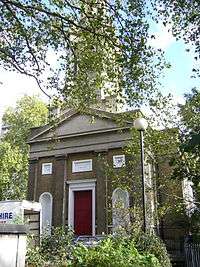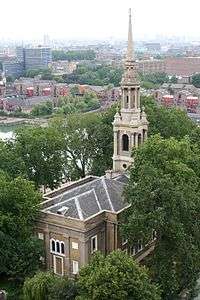St Paul's Church, Shadwell
Coordinates: 51°30′34″N 0°3′9″W / 51.50944°N 0.05250°W
| St. Paul's Church, Shadwell | |
|---|---|
|
St Paul's Church, Shadwell | |
| Country | United Kingdom |
| Denomination | Church of England |
| Churchmanship | Evangelical |
| Architecture | |
| Heritage designation | Grade II* |
| Architect(s) | John Walters |
| Administration | |
| Diocese | London |
| Clergy | |
| Rector | Phil Williams [1] |


St Paul's Church, Shadwell, is a Grade II* listed Church of England church, located between The Highway and Shadwell Basin, on the edge of Wapping, in the East End of London, England. The church has had varying fortunes over many centuries, and is now very active, having been supported recently by Holy Trinity Brompton Church.
History
The old parish church, traditionally known as the Church of Sea Captains, was built in 1656, and was principally financed by Thomas Neale. It is believed that 75 sea captains are buried at the Church.[2] Matthew Mead was minister of the chapel from 1658 until 1662, when he was replaced after the Reformation for being too non-conformist.[3][4] During the Great Plague of London it was one of five sites in the parish of Stepney used as plague pits.[5][6] It was rebuilt in 1669 as the Parish Church of Shadwell, and in an Act of 1670 by Archbishop of Canterbury William Sancroft, St Paul's Shadwell became a separate parish from St Dunstan's, Stepney, where it had previously been a hamlet.[7][8] The church was named after St Paul's Cathedral, and became the first parish created from St Dunstan's, Stepney since Whitechapel in 1338.[9] John Wesley was a preacher at St Paul's. Captain James Cook worshipped there, as did Jacob Phillip, the father of Captain Arthur Phillip, the first Governor of New South Wales.[10] Cook's eldest son was baptised at St Paul's Church in 1763. Also baptised there were William Henry Perkin, the chemist who discovered the first aniline dye, and Jane Randolph, mother of Thomas Jefferson.[2][11] The 1669 church was built in brick, and measured 87 feet (27 m) by 63 feet (19 m).[12]
The church was demolished in 1817 and the present building, a Waterloo church designed by John Walters, was erected in 1821. It is the only building built by John Walters that still survives.[2][7][13] In the 1840s, half of the churchyard land was bought by the London Dock Company in a compulsory purchase order, in order to expand Shadwell Basin.[9]
In 1950, the building became a Grade II* listed building.[14]
Present
In January 2005, a team from the congregation of Holy Trinity Brompton moved to Shadwell to minister with the existing members of St. Paul's in serving the local area. This follows a number of similar church plants from Holy Trinity Brompton to declining churches around London with the support of the Bishop of London. The Rev Ric Thorpe was licensed as the new Priest-in-Charge on 20 January 2005 with The Rev Jez Barnes assisting him as the associate pastor. Thorpe was appointed Rector in 2010, and left in 2015 to become the Bishop of Islington.[15]
References
- ↑ "MEET OUR NEW RECTOR". St Paul's Shadwell. 3 May 2016. Retrieved 8 May 2016.
- 1 2 3 Winn, Christopher (October 2007). I Never Knew That About London. Ebury Press. p. 149. ISBN 978-0091918576. Retrieved 21 April 2016.
- ↑ Lewis, Samuel (1848). A Topographical Dictionary of England. pp. 51–56. Retrieved 30 May 2016 – via British History Online.
- ↑ A History of the County of Middlesex: Volume 11, Stepney, Bethnal Green. 11. Victoria County History. 1998. pp. 70–81. Retrieved 30 May 2016 – via British History Online.
- ↑ Perry, Keith (28 October 2014). "Some of London's most popular picnic spots on top of plague pits". The Telegraph. Retrieved 21 April 2016.
- ↑ Defoe, Daniel (1832). The history of the great plague in London in the year 1665, containing observations and memorials of the most remarkable occurrences, both public and private, during that dreadful period. Retrieved 21 April 2016.
- 1 2 Wheatley, Henry Benjamin; Cunningham, Peter (February 2011). London Past and Present: Its History, Associations, and Traditions. Cambridge University Press. p. 64. ISBN 978-1108028080. Retrieved 21 April 2016.
- ↑ Palin, William (December 2015). The History Of The Church Of England, From The Revolution To The Last Acts Of Convocation, A, Parts 1688-1717. Palala Press. p. 132. ISBN 978-1347773529. Retrieved 21 April 2016.
- 1 2 "St Paul's Shadwell Conservation Area" (pdf). Tower Hamlets London Borough Council. 7 March 2007. p. 4. Retrieved 21 April 2016.
- ↑ Frost, Alan (1987). Arthur Phillip 1738-1814: His Voyaging. Oxford University Press. p. 1. ISBN 0195547012.
- ↑ Duncan, Andrew (August 2006). Andrew Duncan's Favourite London Walks. New Holland Publishers. p. 176. ISBN 978-1845374549. Retrieved 21 April 2016.
- ↑ Harrison, Walter (1776). "A new and universal history: description and survey of the cities of London". Retrieved 21 April 2016.
- ↑ Adams, Bernard (1983). London Illustrated, 1604-1851: A Survey and Index of Topographical Books and Their Plates. Oryx Press. p. 313. ISBN 9780853657347.
- ↑ "Church of St Paul". Historic England. Retrieved 21 April 2016.
- ↑ "New church plant bishop will be Rev Ric Thorpe". Christian Today. 9 July 2015. Retrieved 21 April 2016.
External links
| Wikimedia Commons has media related to St Paul's Church, Shadwell. |
